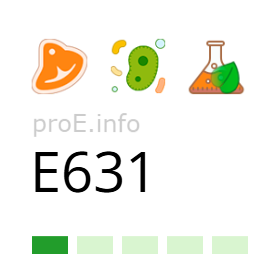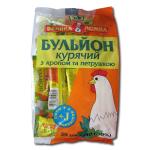
Other names for the additive (synonyms)
General Information
The additive E631 (disodium inosinate) is the disodium salt of inosinic acid — a naturally occurring nucleotide found in RNA.
In nature, disodium inosinate is present in large amounts in the muscle tissue of animals, especially in pork, chicken, and fish. It is responsible for the characteristic umami flavor of meat.
Inosinic acid was first isolated in the late 19th century from meat extracts as a compound involved in energy metabolism (within the purine cycle).
The key discovery of the flavor-enhancing properties of disodium inosinate belongs to two Japanese chemists. In 1908, Kikunae Ikeda identified monosodium glutamate as the compound responsible for the umami taste of kelp broth (kombu). Five years later, in 1913, Ikeda's student Shintaro Kodama isolated 5'-inosine monophosphate (5'-IMP) from meat broth and demonstrated its strong umami flavor. This was a key step in the development of food science and flavor enhancers.
Commercial production of disodium inosinate began in the mid-20th century, initially through extraction from meat and fish tissues. Later, with the development of biotechnology, it was produced by fermenting sugars using bacteria.
Industrial use of disodium inosinate as food additive E631 began in the 1950s–1960s, especially in Japan and other Asian countries, where it was widely used in seasoning blends and bouillon cubes. The additive later became popular in Europe and the United States.
In the food industry, disodium inosinate is classified as flavor enhancer E631. It is most often used in combination with monosodium glutamate (E621) due to their synergistic effect on flavor perception. As a result, it is widely used in the production of bouillon cubes, seasonings, instant noodles, snacks, and chips.
Initially, disodium inosinate was extracted from natural sources — mainly meat or fish tissue rich in ribonucleic acids. This method is expensive and not always acceptable to vegetarians.
Today, E631 is produced via biotechnological synthesis — through fermentation of glucose using Corynebacterium glutamicum or Bacillus subtilis bacteria that are genetically modified to produce inosinic acid, which is then neutralized with sodium. The molecular formula of the resulting disodium inosinate is C10H11N4Na2O8P. This method is more cost-effective and allows production of E631 without using animal-derived materials.
Effects on the Body
Benefits of additive E631
In the human body, inosinate can be used for the synthesis of purine nucleotides and participates in energy metabolism.
This compound also naturally enters the human body through consumption of meat and fish. On average, about 2 g of disodium inosinate may come from a typical daily diet.
Risks of additive E631
The potential for disodium inosinate to cause pathological changes has not been thoroughly studied. Research conducted by the FDA found no carcinogenic, mutagenic, or teratogenic effects. No impact on reproductive function has been confirmed either.
However, some studies suggest that it may cause hypersensitivity in susceptible individuals, especially when combined with E621.
Excessive consumption is not recommended for children under 12 months of age or individuals with gout, as purine compounds increase uric acid levels.
The EFSA Panel on Food Additives and Nutrient Sources added to Food (ANS) did not establish an Acceptable Daily Intake (ADI) for disodium inosinate, since it belongs to the group of nucleotides (E626–E635), which are considered safe when used in technologically justified amounts.
However, according to EU Regulation No 1333/2008, the combined use of nucleotides in food products (including E627, E631, and E635) should be limited to 500 mg/kg of product.
Uses
Additive E631 is mainly used as a flavor enhancer in foods with strong savory taste. It is found in:
- bouillon cubes and soup concentrates;
- seasoning blends and sauces (e.g., soy sauce);
- instant noodles and dried soups;
- chips, crackers, and other snack products.
It is usually combined with monosodium glutamate (E621) and disodium guanylate (E627) to create a synergistic flavor effect.
Legal Status
In the United States and European Union, disodium inosinate is included on the list of approved food additives. In the United States, the FDA does not establish a specific Acceptable Daily Intake (ADI) for sodium inosinate. It is listed as a GRAS substance, meaning it can be used safely when applied in technologically justified amounts.
In the EU, additive E631 is authorized as a flavor enhancer, with specific quantity limits in accordance with Regulation (EC) No 1333/2008.
